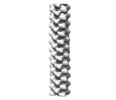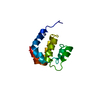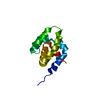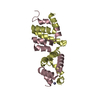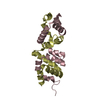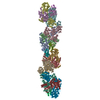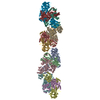+ Open data
Open data
- Basic information
Basic information
| Entry | Database: EMDB / ID: EMD-8976 | |||||||||
|---|---|---|---|---|---|---|---|---|---|---|
| Title | CARD9 CARD helical filament | |||||||||
 Map data Map data | Negative-stain electron microscopy reconstruction of helical filaments of the CARD9 CARD | |||||||||
 Sample Sample |
| |||||||||
| Biological species |   Homo sapiens (human) Homo sapiens (human) | |||||||||
| Method | helical reconstruction /  negative staining / Resolution: 20.0 Å negative staining / Resolution: 20.0 Å | |||||||||
 Authors Authors | Holliday MJ / Estevez A / Rohou A / Dueber EC / Fairbrother WJ | |||||||||
 Citation Citation |  Journal: J Biol Chem / Year: 2018 Journal: J Biol Chem / Year: 2018Title: Picomolar zinc binding modulates formation of Bcl10-nucleating assemblies of the caspase recruitment domain (CARD) of CARD9. Authors: Michael J Holliday / Ryan Ferrao / Gladys de Leon Boenig / Alberto Estevez / Elizabeth Helgason / Alexis Rohou / Erin C Dueber / Wayne J Fairbrother /  Abstract: The caspase recruitment domain-containing protein 9 (CARD9)-B-cell lymphoma/leukemia 10 (Bcl10) signaling axis is activated in myeloid cells during the innate immune response to a variety of diverse ...The caspase recruitment domain-containing protein 9 (CARD9)-B-cell lymphoma/leukemia 10 (Bcl10) signaling axis is activated in myeloid cells during the innate immune response to a variety of diverse pathogens. This signaling pathway requires a critical caspase recruitment domain (CARD)-CARD interaction between CARD9 and Bcl10 that promotes downstream activation of factors, including NF-κB and the mitogen-activated protein kinase (MAPK) p38. Despite these insights, CARD9 remains structurally uncharacterized, and little mechanistic understanding of its regulation exists. We unexpectedly found here that the CARD in CARD9 binds to Zn with picomolar affinity-a concentration comparable with the levels of readily accessible Zn in the cytosol. NMR solution structures of the CARD9-CARD in the apo and Zn-bound states revealed that Zn has little effect on the ground-state structure of the CARD; yet the stability of the domain increased considerably upon Zn binding, with a concomitant reduction in conformational flexibility. Moreover, Zn binding inhibited polymerization of the CARD9-CARD into helical assemblies. Here, we also present a 20-Å resolution negative-stain EM (NS-EM) structure of these filamentous assemblies and show that they adopt a similar helical symmetry as reported previously for filaments of the Bcl10 CARD. Using both bulk assays and direct NS-EM visualization, we further show that the CARD9-CARD assemblies can directly template and thereby nucleate Bcl10 polymerization, a capacity considered critical to propagation of the CARD9-Bcl10 signaling cascade. Our findings indicate that CARD9 is a potential target of Zn-mediated signaling that affects Bcl10 polymerization in innate immune responses. | |||||||||
| History |
|
- Structure visualization
Structure visualization
| Movie |
 Movie viewer Movie viewer |
|---|---|
| Structure viewer | EM map:  SurfView SurfView Molmil Molmil Jmol/JSmol Jmol/JSmol |
| Supplemental images |
- Downloads & links
Downloads & links
-EMDB archive
| Map data |  emd_8976.map.gz emd_8976.map.gz | 1.8 MB |  EMDB map data format EMDB map data format | |
|---|---|---|---|---|
| Header (meta data) |  emd-8976-v30.xml emd-8976-v30.xml emd-8976.xml emd-8976.xml | 12.2 KB 12.2 KB | Display Display |  EMDB header EMDB header |
| Images |  emd_8976.png emd_8976.png | 29.7 KB | ||
| Archive directory |  http://ftp.pdbj.org/pub/emdb/structures/EMD-8976 http://ftp.pdbj.org/pub/emdb/structures/EMD-8976 ftp://ftp.pdbj.org/pub/emdb/structures/EMD-8976 ftp://ftp.pdbj.org/pub/emdb/structures/EMD-8976 | HTTPS FTP |
-Related structure data
- Links
Links
| EMDB pages |  EMDB (EBI/PDBe) / EMDB (EBI/PDBe) /  EMDataResource EMDataResource |
|---|
- Map
Map
| File |  Download / File: emd_8976.map.gz / Format: CCP4 / Size: 2.7 MB / Type: IMAGE STORED AS FLOATING POINT NUMBER (4 BYTES) Download / File: emd_8976.map.gz / Format: CCP4 / Size: 2.7 MB / Type: IMAGE STORED AS FLOATING POINT NUMBER (4 BYTES) | ||||||||||||||||||||||||||||||||||||||||||||||||||||||||||||||||||||
|---|---|---|---|---|---|---|---|---|---|---|---|---|---|---|---|---|---|---|---|---|---|---|---|---|---|---|---|---|---|---|---|---|---|---|---|---|---|---|---|---|---|---|---|---|---|---|---|---|---|---|---|---|---|---|---|---|---|---|---|---|---|---|---|---|---|---|---|---|---|
| Annotation | Negative-stain electron microscopy reconstruction of helical filaments of the CARD9 CARD | ||||||||||||||||||||||||||||||||||||||||||||||||||||||||||||||||||||
| Voxel size | X=Y=Z: 2.006 Å | ||||||||||||||||||||||||||||||||||||||||||||||||||||||||||||||||||||
| Density |
| ||||||||||||||||||||||||||||||||||||||||||||||||||||||||||||||||||||
| Symmetry | Space group: 1 | ||||||||||||||||||||||||||||||||||||||||||||||||||||||||||||||||||||
| Details | EMDB XML:
CCP4 map header:
| ||||||||||||||||||||||||||||||||||||||||||||||||||||||||||||||||||||
-Supplemental data
- Sample components
Sample components
-Entire : Helical filament of the CARD9 CARD
| Entire | Name: Helical filament of the CARD9 CARD |
|---|---|
| Components |
|
-Supramolecule #1: Helical filament of the CARD9 CARD
| Supramolecule | Name: Helical filament of the CARD9 CARD / type: complex / ID: 1 / Parent: 0 / Macromolecule list: all Details: Generated by stripping Zn from 0.2 mM 1:1 CARD:Zn with 0.25 mM EDTA, followed by shaking for 90 minutes at 25C |
|---|---|
| Source (natural) | Organism:   Homo sapiens (human) Homo sapiens (human) |
| Recombinant expression | Organism:   Escherichia coli BL21(DE3) (bacteria) / Recombinant strain: BL21(DE3) Escherichia coli BL21(DE3) (bacteria) / Recombinant strain: BL21(DE3) |
| Molecular weight | Experimental: 22.4 kDa/nm |
-Macromolecule #1: CARD9 CARD
| Macromolecule | Name: CARD9 CARD / type: protein_or_peptide / ID: 1 / Enantiomer: LEVO |
|---|---|
| Source (natural) | Organism:   Homo sapiens (human) Homo sapiens (human) |
| Recombinant expression | Organism:   Escherichia coli BL21(DE3) (bacteria) Escherichia coli BL21(DE3) (bacteria) |
| Sequence | String: GSDYENDDEC WSVLEGFRVT LTSVIDPSRI TPYLRQCKVL NPDDEEQVLS DPNLVIRKRK VGVLLDILQ RTGHKGYVAF LESLELYYPQ LYKKVTGK |
-Experimental details
-Structure determination
| Method |  negative staining negative staining |
|---|---|
 Processing Processing | helical reconstruction |
| Aggregation state | filament |
- Sample preparation
Sample preparation
| Concentration | 2.2 mg/mL |
|---|---|
| Buffer | pH: 7 / Details: 50 mM Tris, 150 mM NaCl, 0.5 mM TCEP, pH 7.0 |
| Staining | Type: NEGATIVE / Material: Uranyl Acetate |
| Grid | Material: COPPER / Mesh: 400 / Support film - Material: CARBON / Support film - topology: CONTINUOUS / Pretreatment - Type: GLOW DISCHARGE |
- Electron microscopy
Electron microscopy
| Microscope | FEI TALOS ARCTICA |
|---|---|
| Electron beam | Acceleration voltage: 200 kV / Electron source:  FIELD EMISSION GUN FIELD EMISSION GUN |
| Electron optics | C2 aperture diameter: 100.0 µm / Illumination mode: FLOOD BEAM / Imaging mode: BRIGHT FIELD Bright-field microscopy / Cs: 2.7 mm / Nominal defocus max: 2.5 µm / Nominal defocus min: 1.2 µm / Nominal magnification: 73000 Bright-field microscopy / Cs: 2.7 mm / Nominal defocus max: 2.5 µm / Nominal defocus min: 1.2 µm / Nominal magnification: 73000 |
| Image recording | Film or detector model: FEI CETA (4k x 4k) / Number grids imaged: 1 / Average exposure time: 2.0 sec. / Average electron dose: 2.0 e/Å2 |
| Experimental equipment |  Model: Talos Arctica / Image courtesy: FEI Company |
- Image processing
Image processing
| Segment selection | Number selected: 1086 / Software - Name: EMAN2 (ver. 2.2) Software - details: Segments were manually picked in e2helixboxer |
|---|---|
| CTF correction | Software - Name: SPRING / Software - details: Using SPRING routine Micctfdetermine. |
| Startup model | Type of model: OTHER / Details: 100 A cylinder generated by SPRING. |
| Final angle assignment | Type: NOT APPLICABLE / Software - Name: SPRING / Software - details: Using SPRING routine Segmentrefine3D. |
| Final reconstruction | Number classes used: 1 Applied symmetry - Helical parameters - Δz: 5.0 Å Applied symmetry - Helical parameters - Δ&Phi: -102 ° Applied symmetry - Helical parameters - Axial symmetry: C1 (asymmetric) Resolution.type: BY AUTHOR / Resolution: 20.0 Å / Resolution method: OTHER / Software - Name: SPRING / Software - details: Using SPRING routine Segmentrefine3D. Details: Approximate resolution estimated by comparison to other NS helical reconstructions Number images used: 11226 |
-Atomic model buiding 1
| Details | No fitting was performed. |
|---|
 Movie
Movie Controller
Controller



